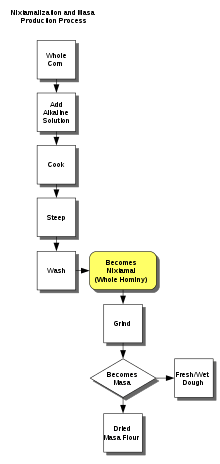Masa
Masa (or masa de maíz) (English: /ˈmɑːsə/; Spanish pronunciation: [ˈmasa]) is a maize dough that comes from ground nixtamalized corn. It is used for making corn tortillas, gorditas, tamales, pupusas, and many other Latin American dishes. Its dried and powdered form is called masa harina, masa de harina, and sometimes Maseca, the name of one commercial brand. The flour is reconstituted with water to make a dough before it is used in cooking.[1]
 The process of making masa from maize | |
| Type | Dough |
|---|---|
| Associated national cuisine | Mexican |
| Main ingredients | Hominy |
In Spanish, masa harina translates to "dough flour", which can refer to many other types of dough.
Preparation
Field corn grain is dried and then treated by cooking the mature, hard grain in a diluted solution of slaked lime (calcium hydroxide) or wood ash, and then letting it soak for many hours. The soaked maize is then rinsed thoroughly to remove the unpalatable flavor of the alkali themselves. This process is nixtamalization, and it produces hominy, which is ground into a relatively dry dough to create fresh masa. The fresh masa can be sold or used directly, or can be dehydrated and blended into a powder to create masa harina, or masa flour.
Lime and ash are highly alkaline: the alkalinity helps the dissolution of hemicellulose, the major glue-like component of the maize cell walls, and loosens the hulls from the kernels and softens the corn. Some of the corn oil is broken down into emulsifying agents (monoglycerides and diglycerides), while bonding of the corn proteins to each other is also facilitated. The divalent calcium in lime acts as a cross-linking agent for protein and polysaccharide acidic side chains.[2]
The chemical changes in masa allow dough formation, and also allow the nutrient niacin to be absorbed by the digestive tract. By contrast, untreated cornmeal is unable to form a dough on the addition of water, and a diet heavily reliant on its consumption is a risk factor for pellagra.[3]
Other uses
The ground product can be called masa nixtamalera. In Central American and Mexican cuisine, masa nixtamalera is cooked with water and milk to make a thick, gruel-like beverage called atole. When made with chocolate and sugar, it becomes atole de chocolate. Adding anise and piloncillo to this mixture creates champurrado, a popular breakfast drink.
Gallery
References
- Kennedy, Diana (1975). The Tortilla Book. Harper and Row. ISBN 9780060123475.
- Harold McGee (2004). On Food and Cooking: The Science and Lore of the Kitchen. New York, New York (USA): Scribner. p. 478. ISBN 978-0-684-80001-1. Retrieved 23 January 2013.
- Food and Agriculture Organization (1992). "Maize in human nutrition". United Nations. Retrieved 2007-01-12. Cite journal requires
|journal=(help)
